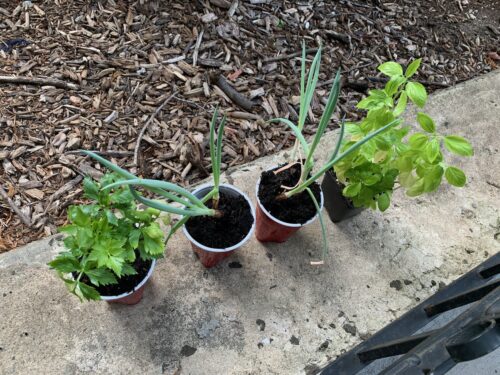Requiem Vegetabilis
Though we haven’t been baking sourdough or whipping coffee, Jess and I aren’t entirely immune to COVID food trends. We’ve made The Stew, The Cookies, and countless pizzas from scratch. Plus, about two months back, driven by Instagram posts featuring the idea, Jess talked me into regrowing scallions and celery from scraps.
Doing so is remarkably easy: you take the bottom inch or two of a scallion or celery plant, submerge it about halfway deep in water, and set it by your window. Et voila, the scallion will begin to grow inch after inch of new stalk, and the celery root will quickly bloom new leaves.
We started out with a rubber-banded bunch of five scallions in a narrow glass, and a celery root in a shallow glass bowl – Jess named them Scarlet and Cecilia, respectively. And, over the course of three or four weeks, they shot up fast enough that the change was obvious day by day. Although my (public, but still rather hippie) California elementary school had a farm on the campus that the students tended, it had been years since I’d grown vegetables, and I’d forgotten how thrilling it is to watch new floral life unfold.
About a month in, however, Scarlet and Cecilia stalled out. Planted in water, they could only draw on the nutrients they already embodied, after which they were stuck, short on the raw materials for further growth. So, we picked up a bag of soil – more expensive than Scarlet and Cecilia had been in the first place – and moved the ladies to two small vases, Cecilia in one, the sisters Scarlet (now spaced out by an inch or two each to give them room for their own roots) in the other.
And, immediately, both started growing again. Somewhere along the way, we also picked up a basil plant, which Jess named Basilio. And, between them all, we had an excellent little window garden going.
In the past week or so, however, we’d seen a couple of flies in our apartment – a rarity in a New York high-rise. And then, last night, Jess realized the source: fruit flies were hatching from the vegetables’ soil, a small swarm surrounding their bases. I briefly Googled for solutions – a layer of gravel atop the soil, traps nearby. But, in the end, we realized that there’s probably a reason most people don’t grow vegetables inside their apartments.
Still, having named the plants, and having watched them sprout, we couldn’t quite bear to just toss them down the floor’s trash compactor chute. We were like the proverbial farmer’s kids, unable to slaughter the pig they’d named and treated as a pet as it grew. So, instead, we transferred the plants to Solo cups, brought them downstairs, and left them on the edge of a planter in front of our building:
Up and down our street – even more so during the pandemic – people regularly leave out books and clothing and household decor they’re getting rid of, for passersby to grab if they’d like. And though, in the end, I realize Scarlet and Cecilia and Basilio are still likely to end up at the bottom of a trash bag, we at least told ourselves that maybe some intrepid neighbor – perhaps one of the many in townhouses with backyards along our block – would take the trio home to their own garden. Hope, like replanted vegetable scraps, springs eternal.










